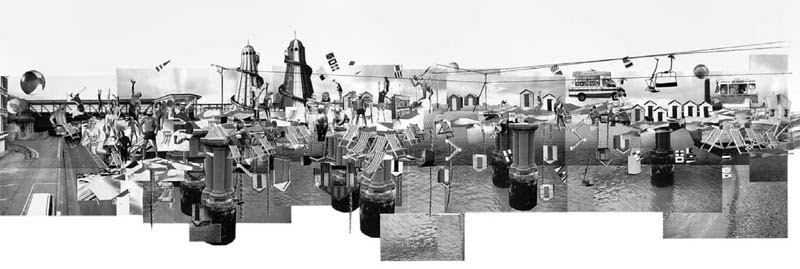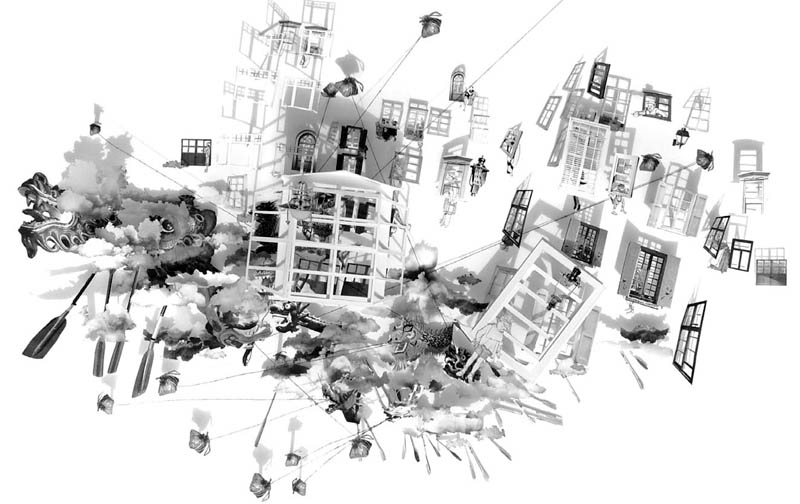

 [Images: From “Dream Isle” by CJ Lim/Studio 8 Architects with Thomas Hillier, Maxwell Mutanda, Rachel Guo, and Ed Liu, from Short Stories: London in Two-and-a-Half Dimensions].
[Images: From “Dream Isle” by CJ Lim/Studio 8 Architects with Thomas Hillier, Maxwell Mutanda, Rachel Guo, and Ed Liu, from Short Stories: London in Two-and-a-Half Dimensions].
I’ve just received a copy of the forthcoming book Short Stories: London in Two-and-a-Half Dimensions by CJ Lim and Ed Liu, and I thought I’d include a few glimpses of it here.
 [Image: From “Carousel” by CJ Lim/Studio 8 Architects with Maxwell Mutanda, from Short Stories].
[Image: From “Carousel” by CJ Lim/Studio 8 Architects with Maxwell Mutanda, from Short Stories].
The book is ostensibly a collection of spatial short stories in which “unexpected environments and places transform into active protagonists.” The stories are “laced with a healthy dose of myth and locational specificity,” as the authors write in the book’s preface.
They continue:
The short stories of this book’s title are set in different time periods of London, intentionally locating themselves in the liminal territory between fiction and architecture to provoke an engagement between readers and their two-dimensional counterparts occupying the depicted city. The stories are neither illustrated texts nor captioned images; the collages represent a network of spatial relationships, and the text, which splices genre such as science fiction, magical realism and the fairy tale, a thread that links some of the nodes of that network together.
In the two following images, for instance, produced by the authors in collaboration with Maxwell Mutanda and Tomasz Marchewka, we see a fictive bridge connecting what are described as the warring tribes of north and south London. There are 214 bridges over the Thames, this story goes, but every year a new connective filament appears: a 215th bridge.
This bridge, “in contrast to its predecessors, is a transitory connection joining the two halves of the metropolis only between the summer months of June and September, during which a common amnesty is held.”

 [Images: From “Discontinuous Cities” by CJ Lim/Studio 8 Architects with Maxwell Mutanda and Tomasz Marchewka, from Short Stories].
[Images: From “Discontinuous Cities” by CJ Lim/Studio 8 Architects with Maxwell Mutanda and Tomasz Marchewka, from Short Stories].
In other stories, Alice in Wonderland collides with the Playboy Mansion, which arrives for one night, and one night only, in the parks of London, where “underground chambers, replicating the hole through which Alice follows the white rabbit, had been scattered through the garden, capped with circular lenses and mirrors,” optically augmenting this hedonistic underworld.
A “roving telescopic contraption” roams the streets; a leather suitcase pops open and “the habitable spaces within extend and unfold each morning to provide a stage for grooming, relaxation and formal dining”; a landscape illuminated by falling stars is discovered to be watered from below by “networks of metal piping” that “mirrored the arrangement of flowers above.”
Elsewhere, a baker works himself to exhaustion “every day without fail,” perfuming the city with fresh bread from within his “synaesthetic pleasure dome,” its “glorious landscape of smells shifting from fermenting acidity to caramelizing sweetness, a riot of auburn and amber reflecting the fires of the bakery and street lamps outside, a symphony of hissing steam and the pummeling of dough.”
The two images, below, show “nebulous clouds of steam,” like an artificial weather front—its “topiaries of water vapour will become indistinguishable from clouds,” we read—being produced in the baker’s garden.
 [Images: From “The Baker’s Garden” by CJ Lim/Studio 8 Architects with Safia Qureshi, from Short Stories].
[Images: From “The Baker’s Garden” by CJ Lim/Studio 8 Architects with Safia Qureshi, from Short Stories].
There are dragons and summer solstices and mechanical animals roving the streets; butchers’ towers, police on horseback, and a fictional interview with the director of something called the New Battersea Centre for Dogs, who explains how she managed to transform vast circular gasometers into greyhound racing parks.
As novelist China Miéville explained to BLDGBLOG in an interview published here last month, London is a city peculiarly well-suited for these sorts of literary and spatial phantasmagoria: “For various reasons, some cities refract, through aesthetics and through art, with a particular kind of flamboyancy. For whatever reason, London is one of them. I don’t mean to detract from all the other cities in the world that have their own sort of Gnosticism, but it is definitely the case that London has worked particularly well for this.”
 [Images: From “The Nocturnal Tower” by CJ Lim/Studio 8 Architects with Barry Cho, from Short Stories].
[Images: From “The Nocturnal Tower” by CJ Lim/Studio 8 Architects with Barry Cho, from Short Stories].
In Short Stories—where myths are told through photographs of pop-out paper figures and propped-open books—London becomes a city architects will always have the freedom to re-dream, and architecture itself becomes a way to undo the spatial straightjackets we find ourselves within.
But does all this mean that the architect is thus politically neutered, reduced to the role of court jester, telling stories of impossible urban boroughs while the real city takes shape, a graph of nothing but the financial needs of absentee developers, hypnotized by fairy tales of a metropolis that can never be built?
 [Images: From “The Celestial River” by CJ Lim/Studio 8 Architects with Maxwell Mutanda and Sarah Custance, from Short Stories].
[Images: From “The Celestial River” by CJ Lim/Studio 8 Architects with Maxwell Mutanda and Sarah Custance, from Short Stories].
Not at all: architects telling stories with and through complex spatial representations—rather than merely supplying construction documents—brings them into contact with all the arts and sciences that have always and already used the built environment as a framework for larger, abstract ideas. Architectural mythology doesn’t cede anyone’s right—or political ability—to change the city, any more than cinema, games, music, poetry, or narrative fiction might do, despite fundamentalist claims that these operate as nothing but middle-class distractions; in all cases, these and other speculative entertainments are often precisely the reason why new visions of human community, spatial justice, and cathartic well-being arise in the first place.
Of course, spatial tales will inspire some people simply to daydream, but that hardly sabotages architecture’s undeniable power to push others to pursue, with great fervor and enthusiasm, the means of seeing such strange and hallucinatory sights someday come true.
Science fiction is no substitute for science itself, but it is a valuable, if not conceptually indispensable, tool for generating, discussing, and communicating often radical ideas.
And the same is true for architecture’s relationship with architectural fiction: thankfully, the latter will not replace the former—but, again, that’s not its point.
The point of “combining place and fiction,” as Short Stories describes it, is not so that we can sit around infantilizing one another with fairy tales, treating the world as empty spectacle, but to reveal, through projects of great imaginative power, that another world is possible, and architects have a unique ability to chaperone this future earth into existence.
